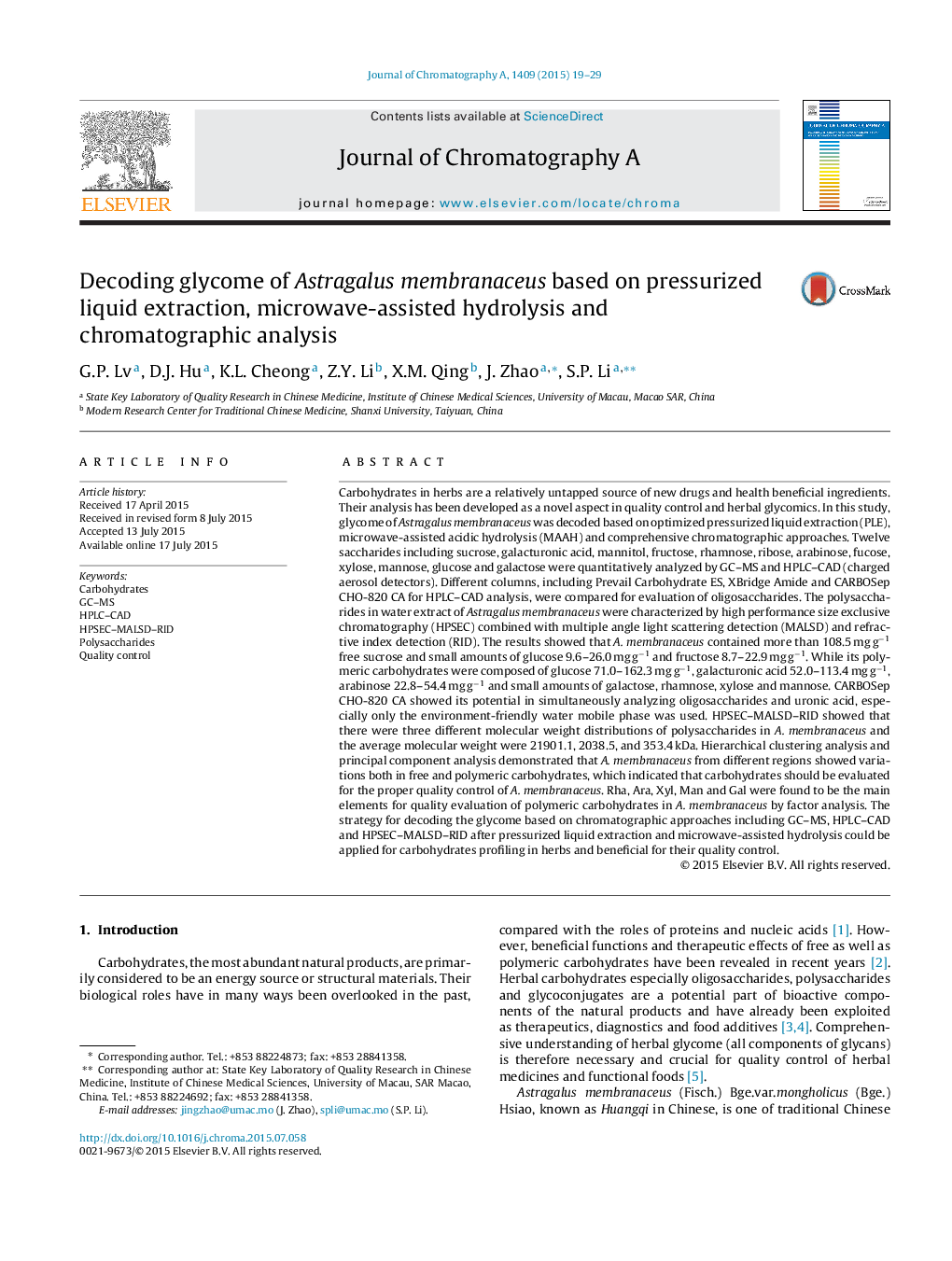| Article ID | Journal | Published Year | Pages | File Type |
|---|---|---|---|---|
| 1198988 | Journal of Chromatography A | 2015 | 11 Pages |
•Glycome of A. membranaceus was decoded by comprehensive chromatographic approaches.•GC–MS, HPLC–CAD and HPSEC–MALSD–RID were applied for decoding glycome.•Free and polymeric carbohydrates were qualitatively and quantitatively determined.•Microwave-assisted hydrolysis greatly improved hydrolysis efficiency.•Established methods could be applied for quality control of A. membranaceus.
Carbohydrates in herbs are a relatively untapped source of new drugs and health beneficial ingredients. Their analysis has been developed as a novel aspect in quality control and herbal glycomics. In this study, glycome of Astragalus membranaceus was decoded based on optimized pressurized liquid extraction (PLE), microwave-assisted acidic hydrolysis (MAAH) and comprehensive chromatographic approaches. Twelve saccharides including sucrose, galacturonic acid, mannitol, fructose, rhamnose, ribose, arabinose, fucose, xylose, mannose, glucose and galactose were quantitatively analyzed by GC–MS and HPLC–CAD (charged aerosol detectors). Different columns, including Prevail Carbohydrate ES, XBridge Amide and CARBOSep CHO-820 CA for HPLC–CAD analysis, were compared for evaluation of oligosaccharides. The polysaccharides in water extract of Astragalus membranaceus were characterized by high performance size exclusive chromatography (HPSEC) combined with multiple angle light scattering detection (MALSD) and refractive index detection (RID). The results showed that A. membranaceus contained more than 108.5 mg g−1 free sucrose and small amounts of glucose 9.6–26.0 mg g−1 and fructose 8.7–22.9 mg g−1. While its polymeric carbohydrates were composed of glucose 71.0–162.3 mg g−1, galacturonic acid 52.0–113.4 mg g−1, arabinose 22.8–54.4 mg g−1 and small amounts of galactose, rhamnose, xylose and mannose. CARBOSep CHO-820 CA showed its potential in simultaneously analyzing oligosaccharides and uronic acid, especially only the environment-friendly water mobile phase was used. HPSEC–MALSD–RID showed that there were three different molecular weight distributions of polysaccharides in A. membranaceus and the average molecular weight were 21901.1, 2038.5, and 353.4 kDa. Hierarchical clustering analysis and principal component analysis demonstrated that A. membranaceus from different regions showed variations both in free and polymeric carbohydrates, which indicated that carbohydrates should be evaluated for the proper quality control of A. membranaceus. Rha, Ara, Xyl, Man and Gal were found to be the main elements for quality evaluation of polymeric carbohydrates in A. membranaceus by factor analysis. The strategy for decoding the glycome based on chromatographic approaches including GC–MS, HPLC–CAD and HPSEC–MALSD–RID after pressurized liquid extraction and microwave-assisted hydrolysis could be applied for carbohydrates profiling in herbs and beneficial for their quality control.
